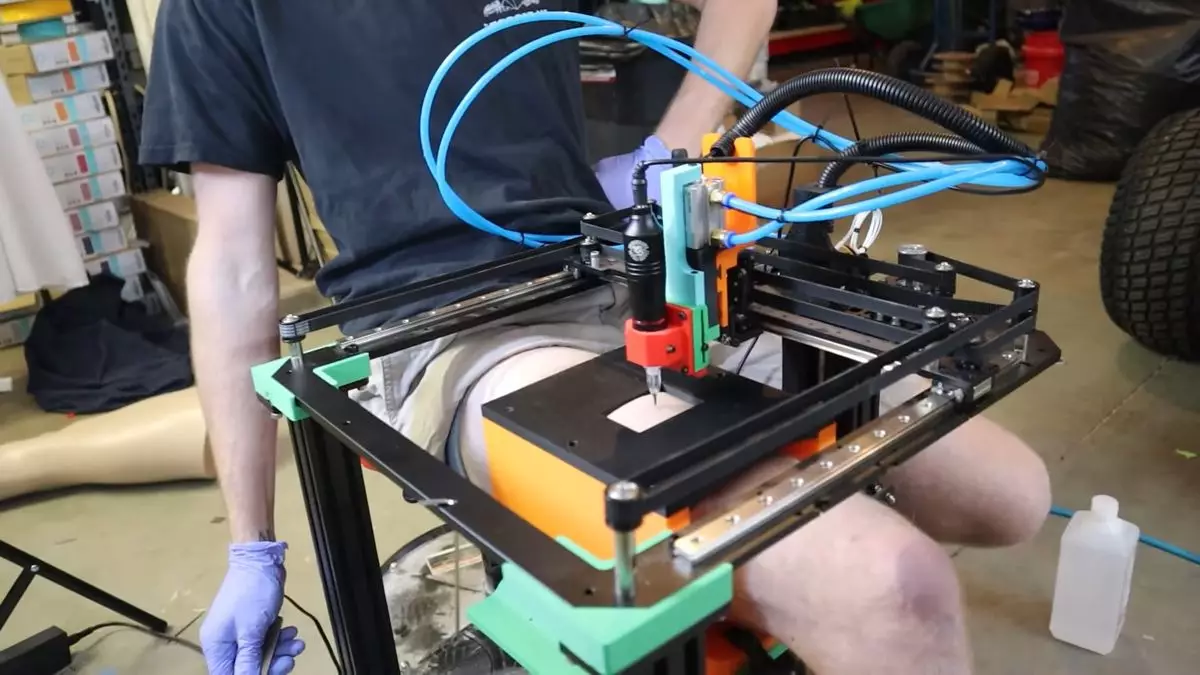In an ever-evolving landscape where technology and art converge, the boundaries of conventional methods seem more pliable than ever. One YouTuber, Emily The Engineer, has ventured into the provocative realm of body art by repurposing a 3D printer into a functioning tattoo machine. This bold experiment raises questions about creativity, safety, and the future of tattooing.
With her singular tattoo design etched onto her skin by a skilled artist, Emily’s motivation to create a more cost-effective tattooing method is intriguing. Armed with a 3D printer, she embarks on a journey that not only leverages the technology but also signals a shift in how personal expression via body art might evolve. The task is not as simple as redirecting machinery from the creation of plastic models to the delicate art of tattooing; it requires Emily to dismantle and fundamentally alter the 3D printer’s design, showcasing her technical prowess and remarkable courage.
Deeply aware of the potential implications, Emily meticulously bypasses the printer’s firmware, demonstrating an understanding of the mechanics at play. This is where an ordinary item transforms into a tool that can potentially inflict pain, as well as provide a medium for aesthetic expression. Such an endeavor certainly flirts with the notion of unconventional innovation, leading viewers to ponder—how far is too far when exploring the union of technology and human experience?
The initial stages of Emily’s project required intricate planning. Once she stripped the 3D printer to its core components, she realized that the transfer from virtual design to living canvas would not be seamless. Tattoos cannot simply be “printed” in the same manner as plastic parts. The nuances of human anatomy pose various challenges. For instance, the first test subjects were flat surfaces, yet Dan, her volunteer, desired a tattoo on his leg—a decidedly uneven, moving surface. This is where she had to get creative once more.
Instead of undertaking a complete overhaul of her invention, Emily ingeniously developed a custom bracket to flatten the desired area of Dan’s thigh. This crafty solution exemplifies how innovation often comes from constraint, pushing creators to think beyond conventional approaches. Moreover, she installed a mechanism to elevate the tattoo needle should anything go awry during the process—a crucial safety precaution that underscores the responsibility inherent in such experimental ventures.
The Moment of Truth
Dan’s willingness to become a part of this groundbreaking experiment speaks volumes about both trust and the spirit of adventure in the world of contemporary art forms. As the moment approached where the needle met skin, anticipation ran high. Surprisingly, Dan reported that the sensation was “not bad,” a testament to the unanticipated success of the improvised machine. Yet, it prompts the query—what are the psychosocial implications of body art produced in such an avant-garde manner?
Viewers may find themselves questioning the integrity of a tattoo executed by a modified 3D printer compared to those crafted by human hands. Does the experience hold the same value when mediated through mechanical means, or does it lend an intriguing layer to this kind of artistic expression? Here lies the crux of diving deep into the potential of technology: it challenges traditional methodologies and introduces fresh concepts about craftsmanship and human experience.
Ultimately, Emily’s venture is not merely a technical undertaking but rather a compelling narrative about the fusion of art and technology. While the outcome might not resemble the streamlined vision of a futuristic tattoo machine, the experiment broaches an essential dialogue about creativity, the spirit of innovation, and the essence of what it means to create.
As the lines between different forms of expression blur, one must consider the implications for both the audience and the artists. In an age when DIY culture celebrates the individual’s ability to create, Emily’s project may well inspire others to rethink boundaries and pursue innovative techniques in the realm of body art and beyond. So can we expect to see more adventures of this sort? The answer, undoubtedly, is yes—and the world of tattoos may never be quite the same.


Leave a Reply